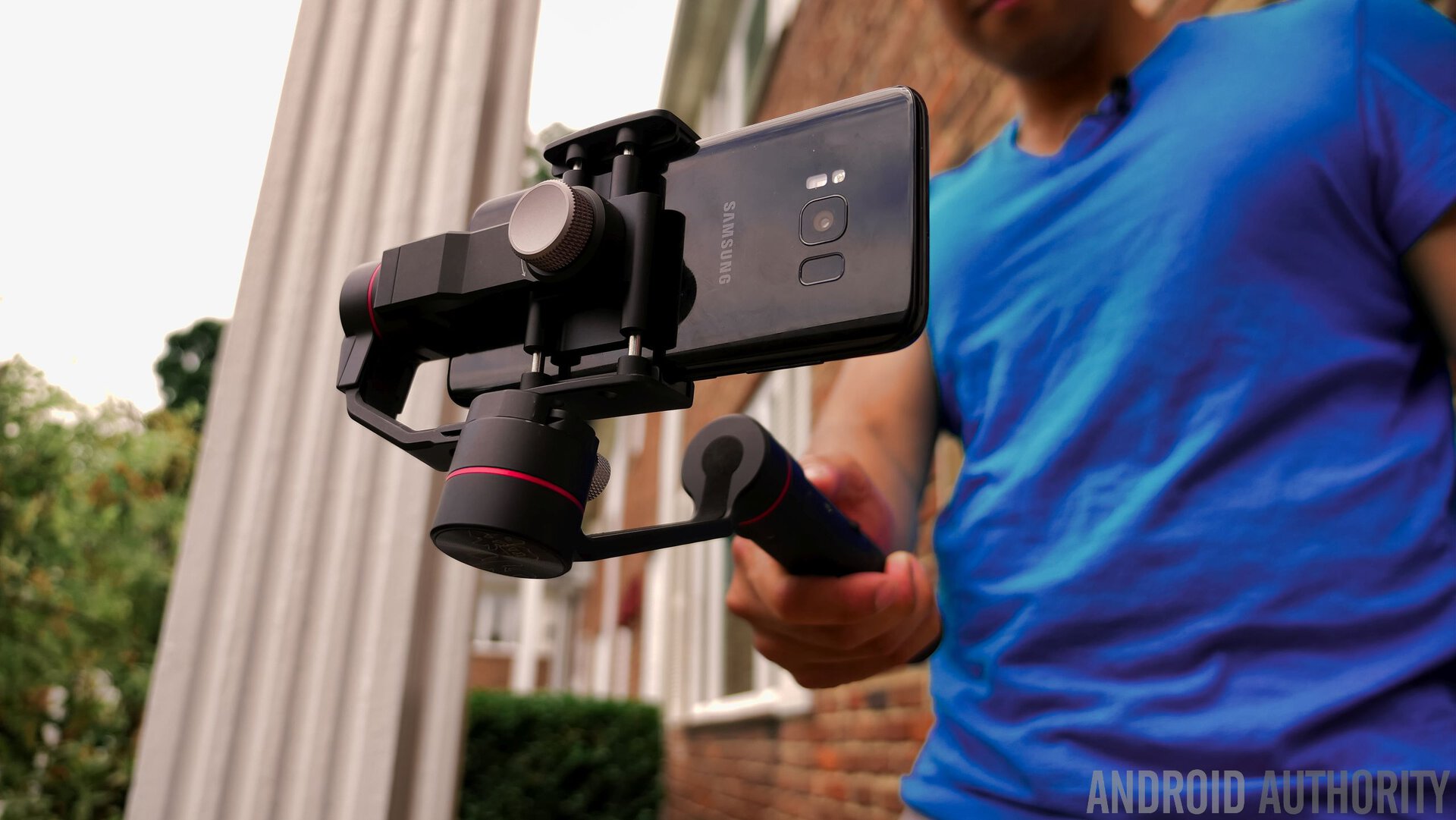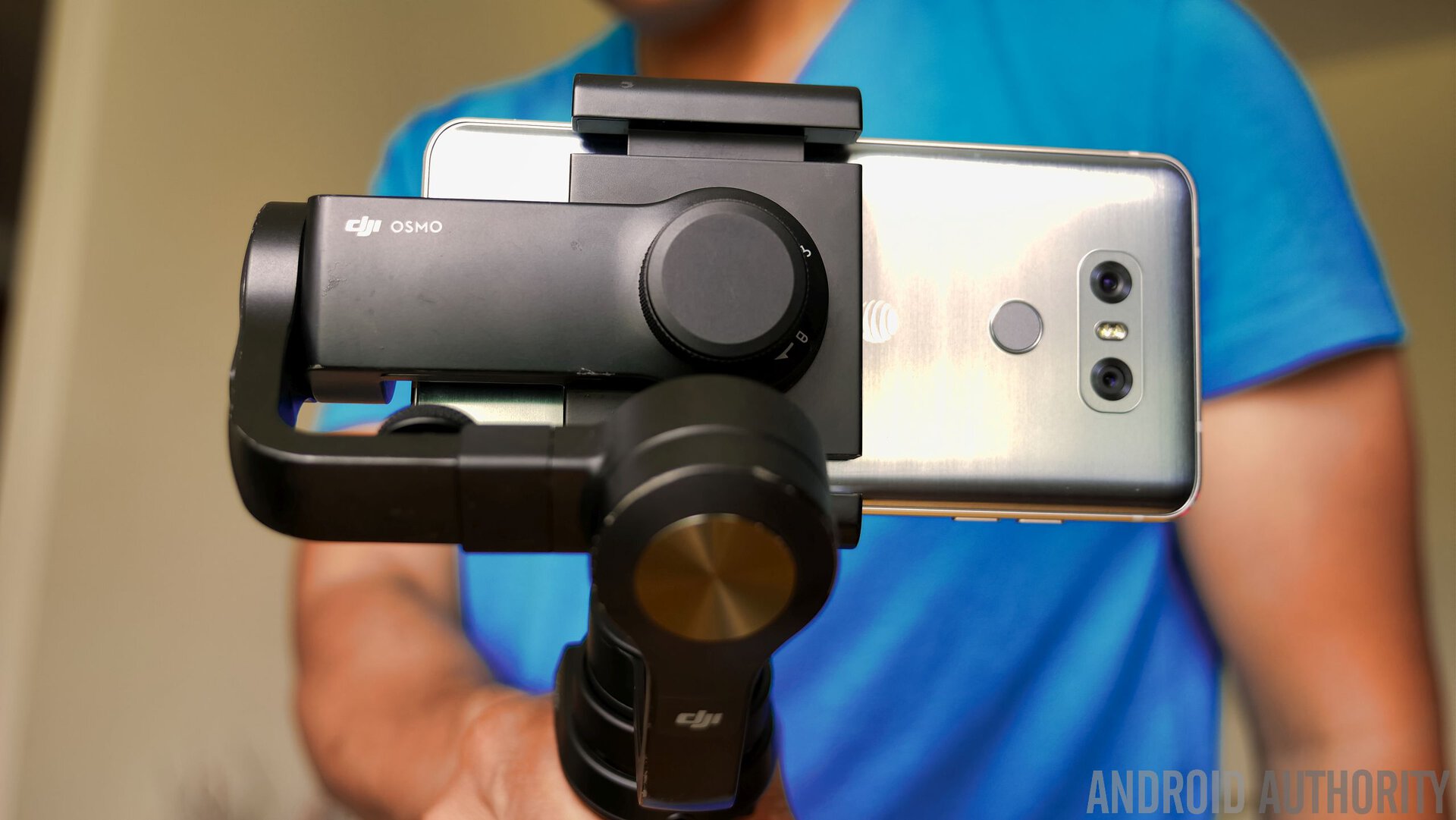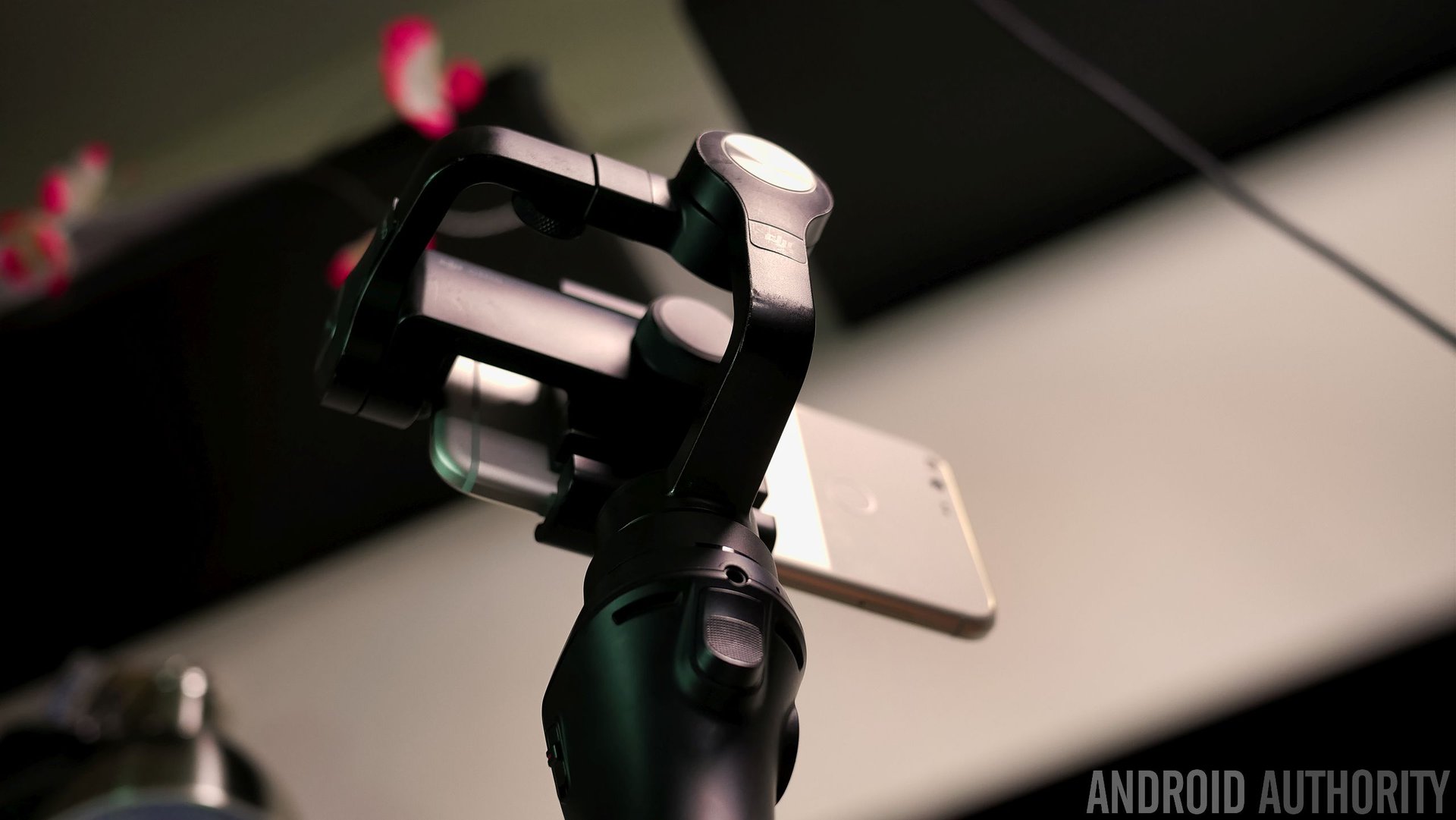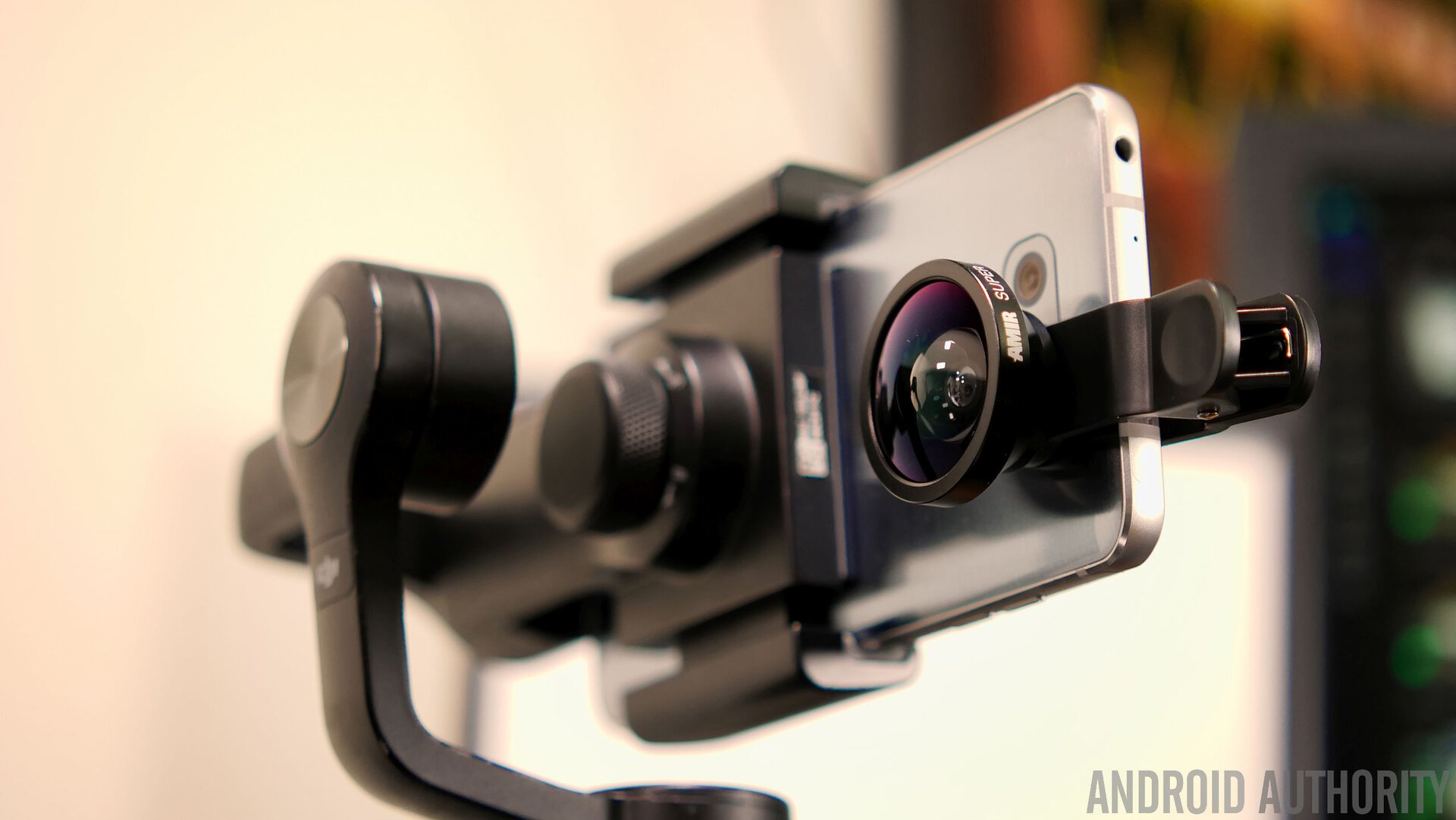Affiliate links on Android Authority may earn us a commission. Learn more.
Are smartphone gimbal stabilizers better than OIS?

Over the course of the last year, I’ve been increasingly seeing a strange new gadget at the industry events and conventions I attend. You’ve probably seen them as expensive alternatives to selfie sticks, but smartphone gimbals are increasingly being used by consumers to help them achieve a Steadicam video effect. I personally own a gimbal stabilizer for my mirrorless camera, and I know first hand what kind of advantages it offers over the built-in stabilization in my camera.
Read Next: Best selfie sticks for smartphones
But then again, many smartphone makers have touted the incredible usability of the optical image stabilization features in their phones – ensuring smooth and steady footage simply by holding onto the phone and nothing else. While this is indeed something that functions well, especially in comparison to non-stabilized footage, it begs the question: how much does the quality really improve when you use a smartphone gimbal, and is it worth paying that much extra for it?
The gimbals
We’ve compared two different smartphone gimbals to give you a thorough analysis of the advantages (if any) over over your standard OIS. We’ve used two very popular smartphone gimbals, the DJI Osmo Mobile and ZHIYUN Smooth 3, both of which are currently priced at $300. Let’s see exactly how they compare against the OIS features in today’s phones.
These are arguably two of the most popular smartphone gimbals, offering similar features that help you to achieve that “walking on air” cinematic look. At the core of it all, these gimbals balance the weight of the attached smartphone, ensuring they’re level and can articulate smoothly. Setup for the most part is a simple process, unlike gimbals for mirrorless cameras that require constant tuning. Installing them involves just placing them into the cradle holders and adjusting the arms so that they’re almost level and steady. And then it’s compensated for by the working motors.

The smartphones
We’ve used the Samsung Galaxy S8, HUAWEI P10, LG G6, and Google Pixel XL, just to try and cover the gamut. All of these phones are highly revered for their impressive camera performance, but more importantly for video, they’re accompanied by image stabilization systems that help them to achieve steadier results when recording video footage. For video in particular, stabilization is an absolutely crucial feature because it largely determines the usability of the resulting videos.
Watching shaky video is not only distracting, it also lessens the overall production quality of your moving camera efforts. Even with all of the improvements made to OIS in smartphones, it’ll be intriguing to see how much these gimbals will help to improve it. And considering that smartphones can rival the quality put out by modern DSLRs and mirrorless cameras when shooting video under ideal situations, such as landscape shots with abundant lighting, gimbals might prove their worth in being a staple smartphone addition to regular consumers.

The settings
In order to achieve uniformity with this comparison, we set all the phones to shoot at 1080p resolution at your typical frame rate of 30 frames per second. Each phone recorded footage while walking with OIS turned off initially, and then turned on later, and then using them with each of the two gimbal stabilizers (first with the phone’s OIS turned on and then off). In essence, we produced six different recordings with each phone to show you the difference using them handheld only and then with the gimbals.
We left the phones to record under the automatic setting, seeing that we’re just comparing the stability with each scenario and don’t really need to take into consideration other aspects of their recording qualities. While all the Android phones we used for this comparison offer the ability to manually turn on/off stabilization, there’s no way to fully disable OIS with the iPhone 7 – even if you use the DJI app (which disables OIS on the iPhone 7) the lens still jiggles.
The results
Before proceeding to read the results, you might want to check out the video above because it perfectly depicts the performance between OIS-enabled smartphones and gimbals. Firstly, it should be noted that OIS greatly improves the stability and footage with all four Android phones we used in this comparison. Simply relying on a steady hand isn’t enough, evident in the jittery footage we see from basic movements like walking on flat surfaces.
More of that jitter and shakiness can be seen while traversing stairs, as the non-stabilized shots are just riddled with too much movement – rendering them useless for professional work. On the flip side, however, enabling OIS in them produces significantly better results! It’s seriously night and day, making OIS a huge asset in a phone’s arsenal. Now, the only question that remains is whether or not smartphone gimbals can go the extra step?
Shooting the same segment with each smartphone and gimbal, with OIS turned on and off as well, we’re confident in our findings that smartphone gimbals do indeed make a difference. What’s most apparent is their ability to smoothen movements going up and down stairs. They just makes movement look much more fluid than simply relying on OIS by itself. Both smartphone gimbals do a great job of achieving that “walking on air” look, but in some instances, the combination of using the gimbals with the phone’s OIS enabled eliminates some of those subtle rocking motions we see while walking.
In all scenarios, though, we can proclaim that the smartphone gimbals deliver superior results over just using OIS by itself. Movements such as turning left and right benefit from using a smartphone gimbal, just because these gimbals will not only keep them level, but they’re designed to smoothly pan towards the direction you’re going – resulting in some truly cinematic movements. Even with more rigorous action, such as running, these smartphone gimbals are undeniably more effective at stabilizing the movement.

Add-on lenses help to create more of that cinematic look
Lastly, we also want to quickly mention how smartphones can achieve even more cinematic quality besides the combination of using OIS and gimbals. One of the easiest ways to achieve that look is to use an add-on lens system over your smartphone’s camera to offer even more versatility and diversity to your compositions. Take for example the inexpensive Amir 3-in-1 lens kit, which offers attachments for wide-angle, fisheye, and macro lenses.
The wide-angle one in particular, is extremely valuable for shots using a gimbal, as more of the scenery can be shown in the recording. And you know what else? You can use these attachment lenses on the front-facing cameras as well! For any vloggers out there, it’ll be an invaluable item in your tool kit — a perfect combination to produce stabilized scene-setting footage as you’re walking. Lastly, sports enthusiasts will also appreciate the fisheye lens, which, when paired with a gimbal, can produce some wicked actions shots.
When it comes to that buttery smooth and stabilized look, smartphone stabilizers are undeniably more effective than simply relying on OIS — and even more so when sudden movements are involved. However, you can achieve yet another level of production improvement with the help of these simple add-on lenses for smartphones.

OIS is great, but stabilizers are even better
Even with all the advancements made with OIS in today’s smartphones, there’s still a wide gap in achieving the same level of steadiness that smartphone gimbals produce; even without having any form of OIS in the phone! The deciding factor here, of course, boils down to cost and how much you’re willing to invest in a smartphone gimbal. The two used here for the comparison, the DJI Osmo Mobile and ZHIYUN Smooth 3, will cost $300 to purchase right now.
While that sum is significant, just know that gimbals for DSLRs and mirrorless cameras typically start at almost double that cost. Thankfully, smartphone gimbals offer many of the same valuable features in a lighter format that make them perfect for mobile enthusiasts. From their ability to stabilize various kinds of movement to their different follow modes and even built-in controls, smartphone stabilizers are versatile tools in an inspiring videographer’s collection.
Slow-motion shots, for example, can be further accentuated by movement from the gimbals, as well as mixing up the speed of the video in post. The point I’m making here is that if you want to get closer to shooting cinematic video without investing in a DSLR and even more expensive gimbal, a smartphone gimbal should absolutely be on your shopping list. In many cases you’ll achieve similar results, especially if you invest in a lens kit as well.
$300 is still a hefty investment regardless of your budget, but smartphone gimbals still prove their worth over just using the in-body OIS systems in smartphones. Fortunately once you buy one, you’ll be able to use it for years with subsequent phones too. The technology in both OIS/EIS and gimbals has come a long way and continues to evolve, so we’re intrigued to see how the gap is further bridged in years to come. Currently, however, we’ll hand it to these gimbals when it comes to achieving those cinematic movements.